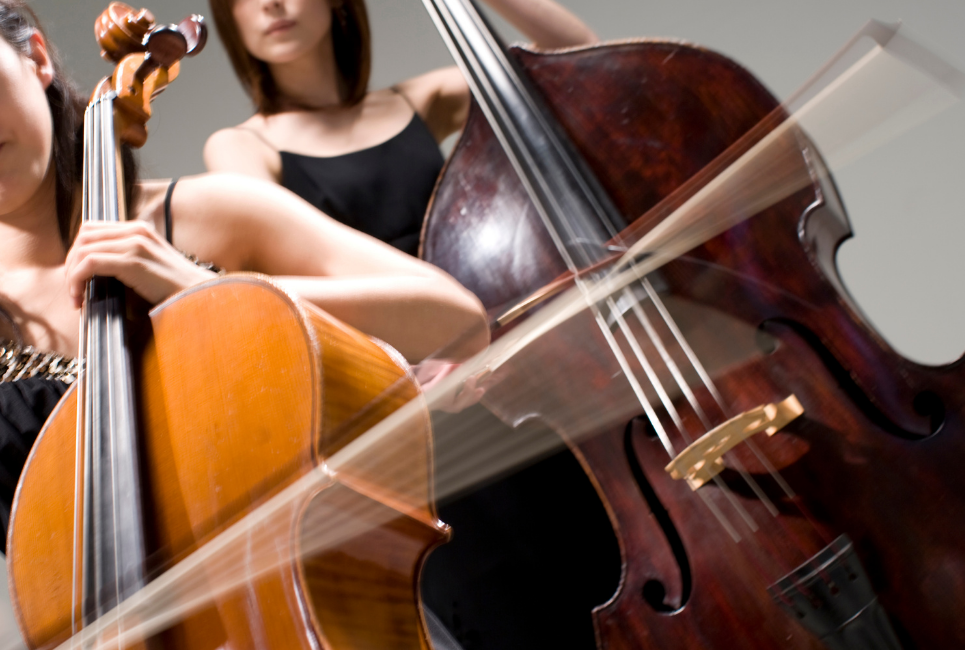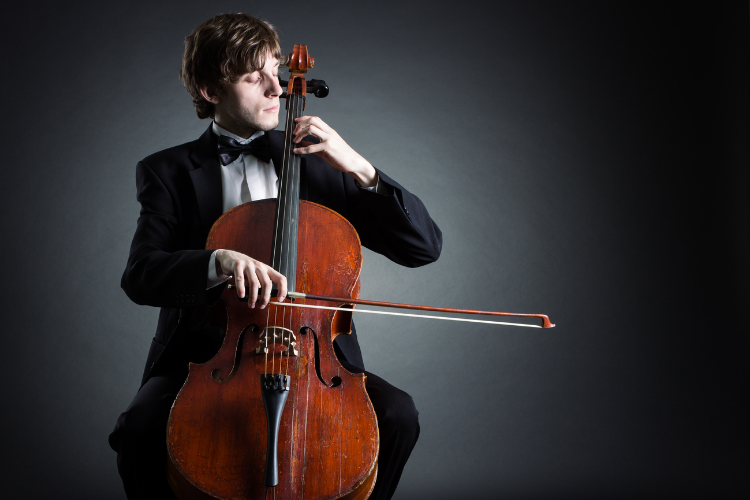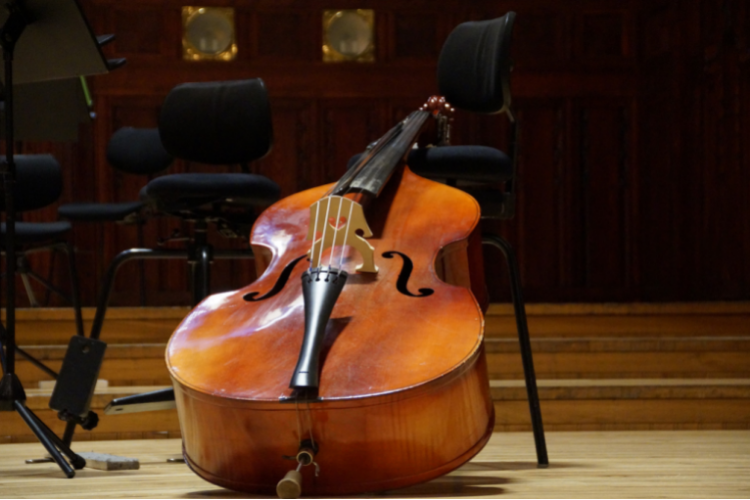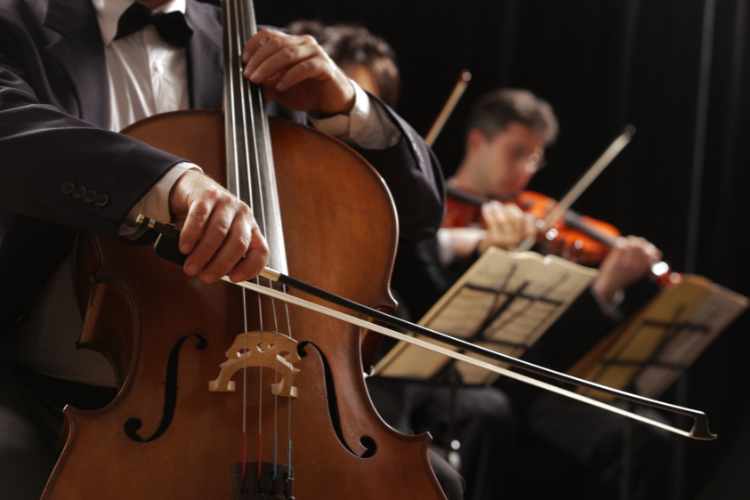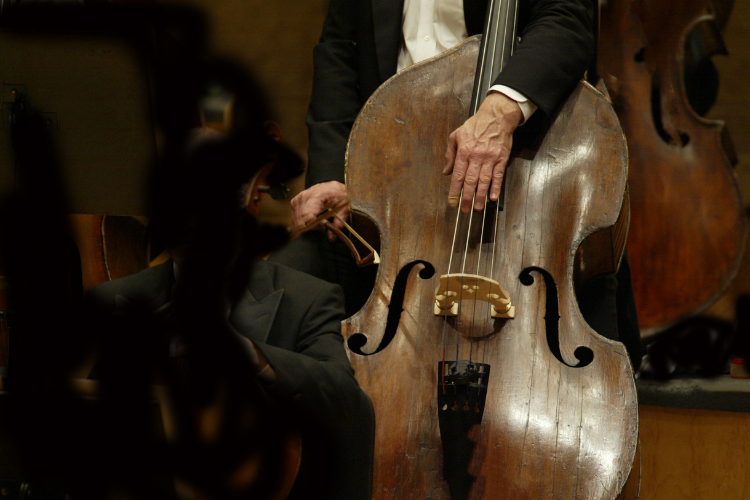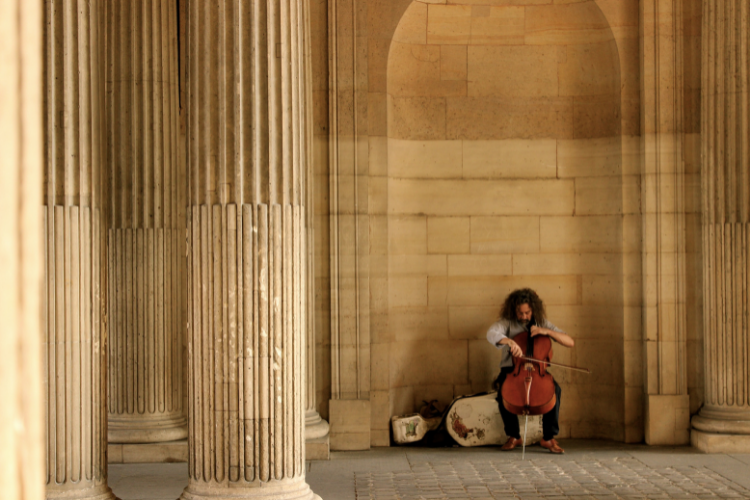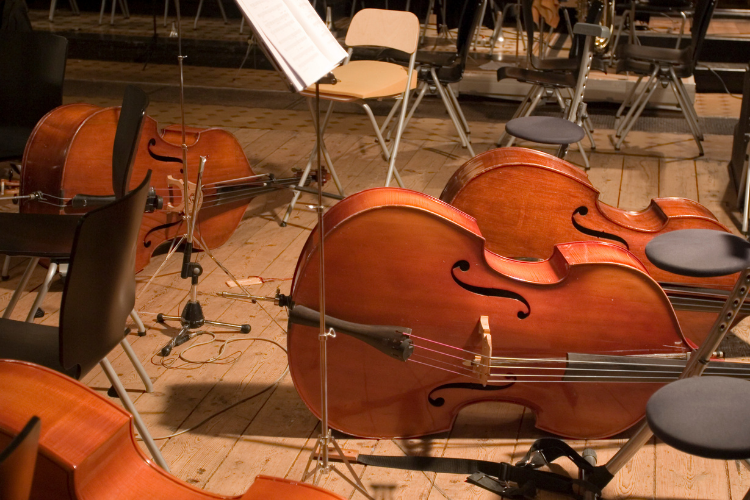- How to Clean Trumpets - May 31, 2022
- How to Find the Best 5 String Violas - May 31, 2022
- Cecilio CCO 200 Review and Guide - April 1, 2022
Classical orchestras are generally built up of four key areas – woodwind, brass, percussion, and strings. This last section has always caught my ear, and from a very early age, I was insistent that I was going to master a stringed instrument.
I tested several different instruments as a child, including the violin and the viola. I enjoyed practicing both, but nothing compared to the experience of bowing a cello or a double bass. The tones that they produced were significantly lower than treble-based instruments, and I was hooked on these deep frequencies instantly.
However, it wasn’t until I had learned the basics in both of these instruments that I truly understood the difference between them. The cello and the double bass can seem very similar initially, but they are pretty different.
If you’ve ever wondered about this yourself, read on to find out more, as I will be explaining exactly how a cello and a double bass differ from each other.
The Size
If there is any difference between the cello and the double bass that is particularly explicit, it’s the size difference. Go ahead and take a look at some comparison pictures online – they are worlds apart in terms of size. However, they are still both the largest stringed instruments in an orchestra.
Firstly, let’s take a look at the size of the cello. Much like other stringed instruments such as the violin, cellos come in a variety of different sizes.
The standard cello for adult performers is known as 4/4 or ‘full size,’ reaching a height of over five feet and a back length of over 30 inches. 7/8 cellos are also popular sizes for smaller adults since the back length is reduced to as low as 27 inches.
That’s a pretty big instrument. I can always remember feeling intimidating when I first laid my hands on a full-sized cello. However, the size immediately feels dwarfed when you compare it to the giant double bass.
Some double basses reach an enormous six feet in height; that’s almost an entire foot taller than the largest cello size! However, the sizing system is slightly different when it comes to the double bass to accommodate the impracticality of the larger sizes.
While 4/4 is the most common size for cellos, the most common double bass size is 3/4, clocking in at over five feet. This is generally considered the appropriate size for the average-sized adult. Full-sized 4/4 double basses are more suitable for larger adults and reach around six feet in height.
Cellos and double basses can both be bought in a variety of adult and children sizes, so you shouldn’t feel anxious – there will be a size that fits you! However, it is undebatable that double basses are much larger and heavier than cellos overall.
The Range
Now that we’ve got the obvious size difference out of the way let’s consider something more musical – the frequency range. Most musical instruments (except for some percussion and electronic instruments) produce periodic sound frequencies. In the case of stringed instruments, this is produced by the bowing of a string.
The bow’s hairs will vibrate against the strings of a cello or a double bass, which will produce an oscillation (or note). However, the size of the instrument’s body and the type of strings result in significant differences in terms of which frequencies or notes are produced.
Ultimately, this all comes down to octave – cellos and double basses can both produce the same notes. Still, the frequencies of these notes will vary depending on the octave that they are played. The available octaves on a cello differ from those accessible on double basses, hence why they have a different frequency range.
Cellos produce deep, rich, and low tones that could never be produced on treble instruments such as the viola and the violin. The lowest note you can produce on a cello is C2 (or 65.41Hz), two octaves below the classic ‘middle C’ note. On the other hand, the highest note on a cello is A5 (or 880 Hz).
C2 may seem pretty low in comparison to other instruments, but it’s nothing compared to the double bass. I was massively interested in the deep tones of the cello, but when I first heard a double bass, I felt the low frequencies resonate through my body.
The double bass has a lower frequency range overall. The lowest standard note is E1 (or 41.2 Hz), meaning the instrument can play several semi-tones lower than a cello. However, this can be extended further when using a five-stringed double bass to reach the incredible low note of B0 (30.87hz), extending the low range even more.
However, whilst the double bass can produce much lower tones than a cello, it cannot compete in terms of high frequencies. The highest note that a four-string double bass can produce is G4 (392 Hz), and this is over an octave lower than the highest note producible by a cello.
The Tuning
The pitch frequencies that any periodic instrument can produce all come down to the tuning. Take a guitar, for example – you could theoretically tune this instrument down several octaves from its standard tuning to produce the heavy and dark tones found in heavy metal music.
I learned the guitar before I learned the cello and the double bass, so my first instinct when I held these classical instruments was to try and change the tuning. My music teacher promptly scolded me for this, telling me that classical stringed instruments should always be tuned in the same way.
Cellos and double basses are tuned completely differently despite their conventionally fixed tunings. Cellos are tuned in fifths across the four strings, with the tuning consisting of C2, G2, D3, and A3. However, as if to make things as confusing as possible, double basses are not tuned in fifths but instead in fourths.
The resulting tuning for a four-stringed double bass is E1, A1, D2, and G3. This can get even more confusing if you are using a five-stringed double bass, resulting in a situation where the player can choose between adding the more common B0 string or, the less common C4 string.
I am very fond of the idea of a five-string double bass. As I mentioned earlier, I’ve always enjoyed experimenting with different tunings, and having the choice between adding a lower or higher string has also been exciting to me. Unsurprisingly though, I almost always choose the ultra-low B0 string.
The Positioning
The next notable difference between the cello and the double bass is the position in which it is performed. While I chose to pursue both instruments, positioning is an important factor to consider when playing the cello or double bass.
While both of these instruments rest on an endpin during a performance, the performer must position themselves differently. Cellos will generally be performed whilst sitting on a cello stool, appropriately adjusted to facilitate a comfortable hold and accessible navigation of the fingerboard.
However, the double bass’s large size means that it is almost always performed whilst standing up, without the use of a stool. This is because the full range of the fingerboard simply could not be reached if the performer was sitting down.
However, some double bassists use specialized high stools as a compromise, allowing them to play the instrument in a comfortable sitting position whilst still being able to access the full range of the fingerboard.
Some people find sitting on a stool uncomfortable for prolonged orchestral performances, consequently choosing the double bass over the cello. However, it is more common to find performers who are uncomfortable standing up for an entire performance, hence why cellos are more commonly chosen.
As a compromise, I just bought a high double bass stool which could be lowered, thus allowing me to use it for both cello and double bass performances.
The Type of Music
The final key difference between the cello and the double bass is the types of music in which they are used. Both of the instruments form core components of the string section of an orchestra. Hence, they are both staples in the performance of classical ensembles and chamber music recordings.
However, I believe that double basses are much more versatile instruments when it comes to style. I’ve been to a ton of concerts throughout my life covering all sorts of different musical genres, and I have always been surprised at the regular presence of the double bass.
It’s an instrument that is regularly used in jazz, often accompanied by experimental techniques and unconventional tunings.
Double basses are also common instruments in contemporary music genres such as trip-hop and hip-hop. Whilst this will usually be represented in the form of a sample from a classical or jazz recording, I have been to several trip-hop shows in which the live band has included a double bass performer.
It’s undeniable that the cello can also be found in alternative arrangements – I have seen them being used on stage accompanying acoustic guitar singer-songwriters and even in the backing group of heavy metal bands. However, this is much less common than seeing a double bass at a non-classical concert.
Whilst the reason for this is ultimately subjective, I think it all comes down to bass frequencies. While bass frequencies are balanced within classical music, they are often the key component to contemporary genres such as hip-hop.
The deeper tones of a double bass can present an excellent live alternative to bass synthesizers and guitars. The flexibility of the strings results in bendy bass tones that work well with electronic beats.
Cello or Double Bass – Which is Best for You?
That just about covers all of the major differences between the cello and the double bass, and which of these instruments you decide to pursue is all down to your personal preference. There are a variety of different reasons that people prefer one of these instruments over the other, and it all comes down to taste and comfort.
One of the most important things to consider is the size. As I mentioned earlier, double basses are significantly larger and heavier than cellos. This can have some serious implications on the practicality of learning this instrument.
It can be incredibly laborious for an adult to carry a double bass to daily ensemble rehearsals, let alone the frustrations of a child taking their double bass to school for music practice. Cellos are also heavy and frustrating to carry around. Still, a double bass’s additional size and weight may make you favor its lighter alternative.
The next major thing to consider is the frequency range that you would like to hit. Both of these instruments have a low range in comparison to other instruments in an ensemble.
Still, it’s undeniable that the double bass produces a level of richness and a lower octave that the cello simply cannot match. If you’re craving the sound of organic bass frequencies, the double bass might be the instrument for you.
Finally, I think it’s important to consider what kind of music you like to perform. Sure, if you are only looking to perform within classical ensembles, you can probably skip this thought as both instruments will be suitable. However, if you are interested in forming the bass section of a jazz band, I think that the double bass is a better option.
The cello can be used in any way that you choose to use it. Still, I have generally found that double basses are more versatile and accepted as appropriate instruments in a wider range of contexts.
If you’re still stuck as to which of these instruments you’d like to learn, you should consider taking a day out to your local music store.
As long as the store has a string section, you should be able to test both cellos and double basses out for yourself before you make a decision. Having the ability to test these instruments with the assistance of music store staff can make a world of difference.
Perhaps you will discover that the double bass simply feels ‘right’ or that the cello is more comfortable and less restrictive than the double bass. Try them both out, ask the store as many questions as you can think of, and only then should you make your decision.
Instrument Recommendations
Cello
@distantcowboy WHEN THERE ARE NO MORE TEARS TO CRY ???? #queerart #distantcowboy #fyp #inlove #hearbroken #cellomusic #classicalbae #lgbt #rainbowmafia #gayartists
♬ NO MORE TEARS – Distant Cowboy
Cecilio CCO-500
This is a great student instrument that comes in 3/4 and full size. This cello features a spruce top with a flamed maple neck, back, and sides. The fingerboard and fittings are made out of ebony with four nickel-plated fine tuners. The outfits comes with a hard and soft case perfect for students on the go, a brazilwood bow, rosin, cello stand, and extra strings. While the cello itself is made out of quality materials, ditch the strings and bow for something of better quality. I recommend a carbon fiber bow and at least D’Addario Prelude Strings.
Pros
- Inexpensive Student Instrument
- Comes with everything you need to get started
- Varnish finish, not laminated
Cons
- Will need set up by a professional adding to the cost
- Bow and strings will need replacing as soon as possible
- Fittings may need to be replaced within the year.
Tower Strings Entertainer
This cello by Fiddlershop is a quality student instrument that comes with everything you need to get started. This cello is offered in sizes 1/8 to 4/4, perfect for students of any size. This cello features solid carved spruce and maple tonewoods that have been aged for at least 2 years. The fingerboard and pegs are made out of ebony, and the tailpiece is made with aluminum and features 4 fine tuners. The cello comes strung with D’Addario Prelude strings. The outfit comes with a foam hard case, Fiddlerman carbon fiber bow, rosin, endpin stop, practice mute, polishing cloth, and tuner. This Cello comes fully set up and ready to play by experience luthiers at the Fiddlershop’s main location in Florida. While more expensive, you get a top-quality instrument with quality accessories you don’t have to replace.
Pros
- Comes fully set up with the Fiddlershop guarantee
- Top-quality aged tonewoods
- Quality accessories and fittings
- Gorgeous varnish finish
Cons
- Expensive
- Only a one year warranty
DZ Strad Model 400
This isn’t a Cello for a beginning student; instead, I included this pick for those who have been playing for a while and would like an upgrade. This is an expensive instrument that you can expect to be playing for quite a few years. You may even take it with you into professional orchestras if that is your goal. This cello is made out of solid carved spruce and maple tonewoods. Modeled after the work of Guiseppe Rocca, who took inspiration from both Stradivari and Guarneri, this cello features a beautiful rich tone and powerful projection. The cello’s varnish is hand-rubbed oil to give it an antique appearance. This Cello comes fully set up by the DZ Strad luthiers featuring a rock maple bridge and Larsen A&D strings with Spirocore G&C strings. The cello comes in sizes 1/4 through 4/4, and the outfit features a brazilwood bow, soft case, and rose.
Pros
- Beautifully crafted instrument
- Fully set up and ready to go
- Comes with basic accessories
- Strung with top quality professional strings
- Good quality bridge
Cons
- Really expensive
- No information on the age of tonewoods or fittings
- Doesn’t come with accessories equal to the value of the instrument
Double Bass
Unlike cellos, double basses aren’t offered on Amazon. I assume due to their sheer size of storage and complexity. I focused my search on Fiddlershop and Guitar Center for these instruments, which seems to offer the widest variety of double basses.
@justa_cello5 Please no hate! #bass #bassist #basssoftiktok #basstok #instrument #stringedinstrument #arirang #koreanfolksong #korean #basspart #part1
♬ original sound – Sunrise
Core Academy A40 Double Bass
Outfit by Fiddlershop is a fully set up Double Bass student outfit. This is definitely a student instrument featuring laminated aged maple back and sides. The fittings are complete ebony, and the tuning pegs are Howard Core machine heads. The outfits include a padded bass cover, french style brazilwood bow, polishing cloth, and rosin.
Pros
- Good quality for the price
- Height adjustable maple bridge
- Strung with Helicore strings
- comes with a basic outfit
Cons
- Laminated wood
Cremona SB=4 Premier Novice Upright Bass
This is a great choice for a serious student. This double bass features a hand-carved solid spruce top with solid flamed maple back and sides. The fingerboard is ebonite, a form of synthetic ebony wood; I often see it on student model clarinets. Technically it’s hard rubber, and it is very durable. The nut, tailpiece, and saddle are made of actual ebony wood. This instrument only comes with a padded soft case, requiring you to purchase a bow and other accessories separately.
Pros
- Beautiful finish
- No laminated wood used in construction
- Featured on the Grand Ole’ Opry every night on TV
Cons
- Doesn’t come with a bow
- No information on bridge
Fiddlerman Master Double Bass
This cello by Fiddlershop is for the seasoned bass player. A german pattern bass featuring solid carved Russian spruce and flamed Asian maple tonewoods. The wood is dried for at least 10 years and aged for 75 years. Giving the wood time to settle and produce a warm and beautiful tone. The fingerboard and tailpiece are made out of ebony, and the bass is strung with D’Addario Helicore Bass Strings. The beautiful varnish is hand-rubbed, and the bridge is hand carved from a german pattern. This outfit includes a carbon fiber bow and comes ready to play!
Pros
- Beautiful quality instrument
- Features quality tonewoods and fittings
- Comes with a quality bow
Cons
- Expensive
FAQ
Before we finish things off, I thought it might be helpful to answer some of the most frequently asked questions that I receive regarding cellos and double basses. My answers have helped a ton of friends and students, and I hope that they help you too.
Answer: No – double basses are significantly larger than cellos, with some full-sized models reaching six feet in height, whereas cellos are generally no larger than five feet.
Answer: Yes – cellos are tuned in fifths and follow the tuning of C2, G2, D3, and A3, whereas the double bass is tuned in fourths and follows the tuning of E1, A1, D2, and G3.
Answer: Violins and violas are relatively small stringed instruments that produce mid to high-frequency tones, whereas cellos and double basses are significantly larger and produce much lower tones.
Answer: No – unlike most stringed instruments that use the standard size of 4/4, the standard size for a double bass is generally considered to be ¾, with 4/4 being reserved for particularly tall performers.
Final Verdict
I’ve covered a huge amount of information in this guide, so I hope that you are finishing this article with a clear understanding of the differences between cellos and double basses. They are both fantastically majestic instruments that produce rich and low tones that every orchestra requires, and I am regularly baffled as to how they are not more popular choices.
I have to say that my personal favorite is the double bass. I love having access to the additional seven lower semi-tones. The loss of the higher frequencies of a cello does not bother me.
It’s also a great feeling turning up to a jazz or contemporary music ensemble with a double bass and having it accepted by the band members as a viable musical addition. I certainly have cellist friends who perform in unconventional ensembles. Still, the instrument is just not quite as versatile as the double bass, in my opinion.
So, will you choose the large build and low tones of the double bass or the sit-down style of the cello? It’s a decision only you can make, but don’t forget to test both out in a music store to help you make your decision. Good luck!
For more interesting readings, check out:

